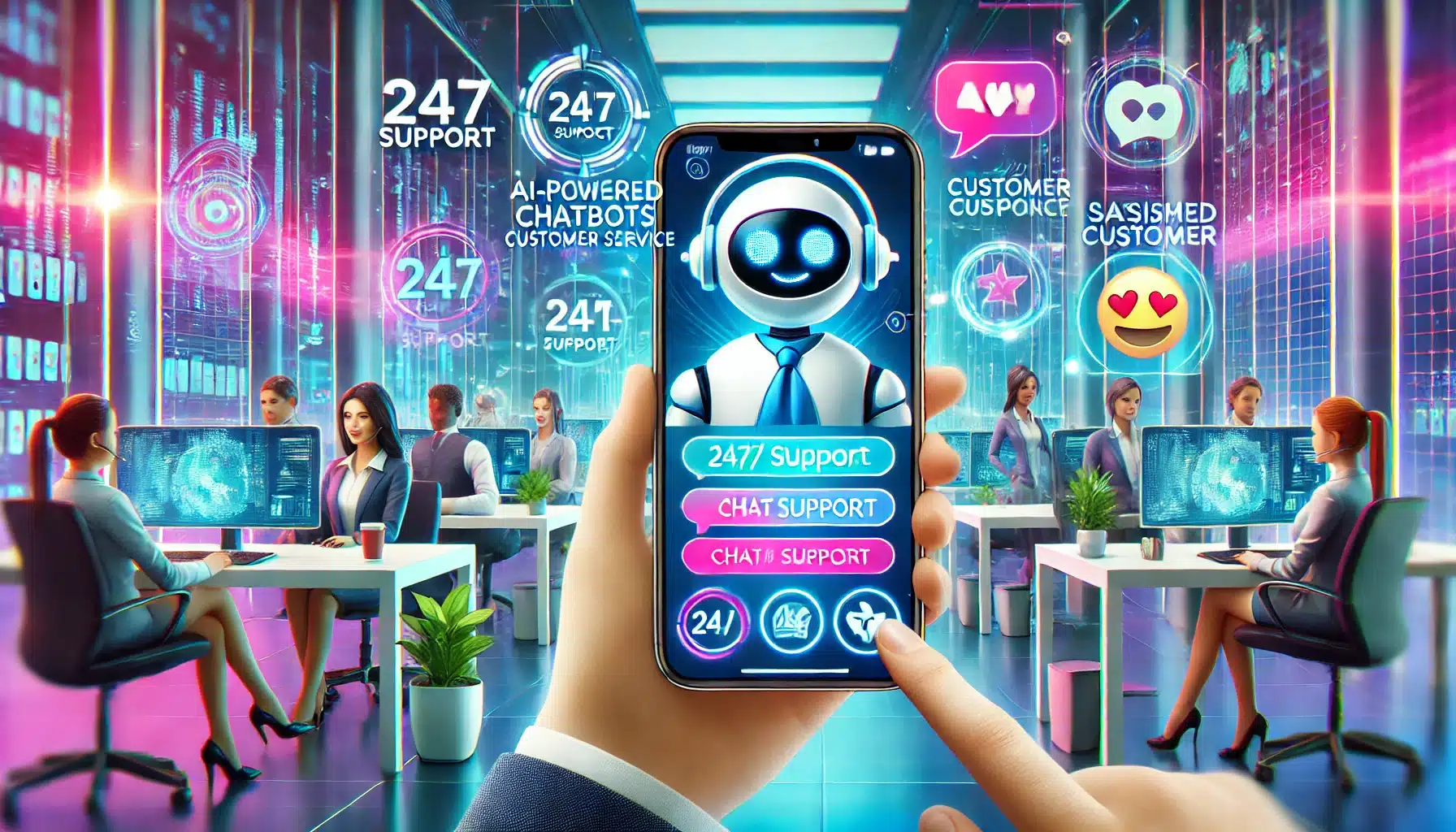Introduction:
In today’s fast-paced digital world, customer service has become a critical differentiator for businesses across all industries. As consumers demand quicker responses and more personalized interactions, companies are turning to artificial intelligence (AI) to meet these evolving needs. At the forefront of this technological revolution are AI-powered chatbots, which are dramatically reshaping the landscape of customer service.
This blog post will explore how AI chatbots are revolutionizing customer service, the benefits they bring to both businesses and consumers, and what the future holds for this transformative technology. We’ll delve into real-world examples, expert insights, and practical tips for implementing chatbots in your own customer service strategy.
The Rise of AI-Powered Chatbots
Remember the days when you had to wait on hold for hours to speak with a customer service representative? Or when you’d send an email and wait days for a response? Those frustrating experiences are becoming a thing of the past, thanks to the advent of AI-powered chatbots.
Chatbots have come a long way since their inception. Early versions were simple rule-based programs that could only handle basic queries. Today’s AI-powered chatbots, however, are sophisticated virtual assistants capable of understanding context, learning from interactions, and providing personalized responses.
The global chatbot market is experiencing explosive growth. According to a report by Grand View Research, the market size is expected to reach $1.25 billion by 2025, growing at a compound annual growth rate (CAGR) of 24.3%. This surge is driven by advancements in natural language processing (NLP), machine learning, and the increasing adoption of chatbots across various industries.
How AI Chatbots Are Transforming Customer Service
- 24/7 Availability
One of the most significant advantages of AI chatbots is their ability to provide round-the-clock customer support. Unlike human agents who need breaks and sleep, chatbots can work tirelessly, ensuring that customers receive assistance at any time of day or night.
Case Study: Spotify’s Customer Service Transformation
Spotify, the popular music streaming platform, implemented an AI chatbot named “SpotifyBot” to handle customer inquiries. The result? A 50% reduction in response times and a 30% increase in customer satisfaction scores. By offering instant support at all hours, Spotify has significantly improved its customer experience.
- Instant Response Times
In an era of instant gratification, customers expect quick answers to their questions. AI chatbots excel in this area, providing immediate responses to common queries. This speed not only improves customer satisfaction but also allows human agents to focus on more complex issues that require a personal touch.
- Personalization at Scale
AI chatbots can analyze vast amounts of customer data to provide personalized recommendations and solutions. By leveraging machine learning algorithms, chatbots can understand individual preferences, purchase history, and behavior patterns to offer tailored assistance.
Example: Amazon’s Personalized Shopping Assistant
Amazon’s AI-powered chatbot uses customer data to provide personalized product recommendations, answer questions about order status, and even assist with returns. This level of personalization has contributed to Amazon’s reputation for excellent customer service and has helped drive customer loyalty.
- Consistency in Service Quality
Human agents can have off days or inconsistent knowledge levels, leading to varying quality in customer service. AI chatbots, on the other hand, provide consistent responses based on their programming and learning algorithms. This ensures that every customer receives the same high-quality service, regardless of when or how they interact with the company.
- Multilingual Support
For global businesses, providing support in multiple languages can be challenging and expensive. AI chatbots can be programmed to communicate in various languages, breaking down language barriers and allowing companies to serve a diverse customer base without the need for a large multilingual staff.
Success Story: KLM Royal Dutch Airlines
KLM implemented an AI chatbot that can communicate in 13 different languages. This has allowed the airline to provide seamless support to international travelers, resulting in improved customer satisfaction and reduced support costs.
- Scalability and Cost-Effectiveness
As businesses grow, scaling customer support can be a significant challenge. AI chatbots offer a cost-effective solution to this problem. They can handle an unlimited number of conversations simultaneously, allowing companies to manage increased customer inquiries without a proportional increase in staff.
- Data Collection and Analysis
AI chatbots not only provide support but also gather valuable data on customer interactions. This data can be analyzed to identify common issues, improve products or services, and refine the chatbot’s responses over time.
Overcoming Challenges in AI Chatbot Implementation
While the benefits of AI chatbots are clear, implementing them successfully requires careful planning and consideration. Here are some challenges businesses may face and how to overcome them:
- Balancing Automation with Human Touch
Challenge: While chatbots can handle many queries, there will always be situations that require human intervention.
Solution: Implement a hybrid model where chatbots handle initial interactions and seamlessly transfer complex issues to human agents. This ensures that customers receive the best of both worlds – quick responses for simple queries and personalized attention for more complex issues.
- Maintaining a Natural Conversation Flow
Challenge: Some chatbots can feel robotic or struggle with context, leading to frustrating user experiences.
Solution: Invest in advanced NLP technologies and continuously train your chatbot using real conversation data. Regular testing and refinement of conversation flows can help create more natural and engaging interactions.
- Ensuring Data Privacy and Security
Challenge: Chatbots handle sensitive customer information, raising concerns about data privacy and security.
Solution: Implement robust security measures, including data encryption and secure authentication processes. Be transparent with customers about how their data is used and stored, and ensure compliance with relevant data protection regulations like GDPR.
- Managing Customer Expectations
Challenge: Customers may have unrealistic expectations about what chatbots can do, leading to disappointment.
Solution: Clearly communicate the capabilities and limitations of your chatbot. Use a friendly, approachable tone in your bot’s responses, and make it easy for users to access human support when needed.
The Future of AI Chatbots in Customer Service
As AI technology continues to evolve, we can expect even more sophisticated and capable chatbots in the future. Here are some trends to watch:
- Emotional Intelligence
Future chatbots will be able to detect and respond to customer emotions, providing empathetic and contextually appropriate responses. This will further blur the line between human and AI interactions.
- Predictive Customer Service
AI chatbots will become proactive, anticipating customer needs based on data analysis and reaching out to offer assistance before issues arise.
- Voice-Activated Chatbots
As voice recognition technology improves, we’ll see more integration between chatbots and voice assistants, allowing for seamless voice-based customer support.
- Augmented Reality (AR) Integration
Chatbots may incorporate AR technology to provide visual assistance, such as guiding customers through product assembly or troubleshooting.
- Blockchain for Enhanced Security
Blockchain technology could be used to secure chatbot interactions, providing an additional layer of trust and data protection.
Implementing AI Chatbots in Your Business
If you’re considering implementing an AI chatbot for your customer service, here are some steps to get started:
- Identify Your Goals: Determine what you want to achieve with a chatbot, such as reducing response times or handling a higher volume of inquiries.
- Choose the Right Platform: Research different chatbot platforms and choose one that aligns with your needs and technical capabilities.
- Start Small: Begin with a limited scope, focusing on handling common queries in one or two key areas of your business.
- Train Your Chatbot: Provide your chatbot with a comprehensive knowledge base and train it using real customer interaction data.
- Test Thoroughly: Conduct extensive testing to ensure your chatbot provides accurate and helpful responses.
- Monitor and Improve: Regularly analyze chatbot performance and customer feedback to make continuous improvements.
Conclusion
AI-powered chatbots are revolutionizing customer service by providing instant, personalized, and scalable support. As the technology continues to evolve, businesses that embrace chatbots will be well-positioned to meet the growing demands of modern consumers.
However, it’s important to remember that chatbots are not a replacement for human customer service representatives. Instead, they are powerful tools that can enhance and complement human efforts, allowing businesses to provide better, faster, and more efficient customer support.
By carefully implementing AI chatbots and continuously refining their capabilities, businesses can create exceptional customer experiences that drive satisfaction, loyalty, and growth in an increasingly competitive marketplace.
Are you ready to join the AI revolution in customer service? The future of customer interactions is here, and it’s powered by intelligent, conversational AI.


